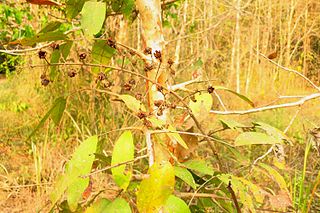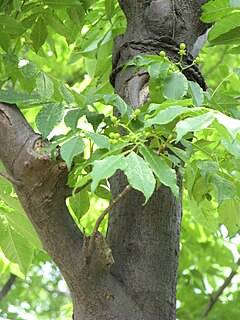Cratoxylum arborescens is a plant in the family Hypericaceae. The specific epithet arborescens is from the Latin meaning "tree-like".

Cratoxylum cochinchinense is a plant now placed in the family Hypericaceae. The specific epithet cochinchinense is from the Latin meaning "of Cochinchina". In Vietnamese C. cochinchinense is usually called thành ngạch nam or lành ngạnh nam, other names include: hoàng ngưu mộc, hoàng ngưu trà and đỏ ngọn.
Canarium littorale is a tree found in tropical Asia and is a member of the incense tree family Burseraceae. The specific epithet littorale is from the Latin meaning "of the seashore", referring to its habitat.
Maranthes corymbosa is a tree in the family Chrysobalanaceae. The specific epithet corymbosa is from the Greek meaning "cluster", referring to the clustered inflorescences.

Picrasma is a genus of flowering plants in the family Simaroubaceae, comprising six to nine species native to temperate to tropical regions of Asia, and tropical regions of the Americas. The species are shrubs and trees growing up to 20 m tall.
Dysoxylum alliaceum is a tree in the family Meliaceae. The specific epithet alliaceum is from the Latin meaning "onion-like", referring to the smell of the inner bark.
Dysoxylum arborescens is a tree in the family Meliaceae. The specific epithet arborescens is from the Latin meaning "tree-like".
Dysoxylum densiflorum is a tree in the family Meliaceae. The specific epithet densiflorum is from the Latin meaning "dense flowers".
Canarium denticulatum is a tree in the family Burseraceae. The specific epithet denticulatum is from the Latin meaning "small teeth", referring to the leaf margin.

Dacryodes rostrata is a tree in the family Burseraceae. The specific epithet rostrata is from the Latin meaning "beaked", referring to the narrow-tipped leaves.
Dacryodes rugosa is a tree in the family Burseraceae. The specific epithet rugosa is from the Latin meaning "wrinkled", referring to the leaflets.
Mastixia cuspidata is a tree in the family Nyssaceae. The specific epithet cuspidata is from the Latin meaning "sharp-pointed", referring to the leaf apex.
Mastixia trichotoma is a tree in the family Nyssaceae. The specific epithet trichotoma is from the Greek meaning "three parts", referring to the three-branched inflorescence.
Anacolosa frutescens, also known as galonut, is a plant in the family Olacaceae. The specific epithet frutescens is from the Latin frutex meaning "shrub".

Brucea javanica is a shrub in the family Simaroubaceae. The specific epithet javanica is from the Latin, meaning "of Java". Other common names in English include Java brucea and kosam.
Gynotroches is a monotypic genus of trees in the family Rhizophoraceae. It contains the single species Gynotroches axillaris. The generic name Gynotroches is from the Greek meaning "woman wheel", referring to the shape of the stigma. The specific epithet axillaris is from the Latin, referring to the axillary position of the flowers.
Buchanania insignis is a tree of Borneo in the cashew and sumac family Anacardiaceae. The specific epithet insignis is from the Latin meaning "remarkable".
Buchanania sessilifolia is a tree in the cashew and sumac family Anacardiaceae. The specific epithet sessilifolia is from the Latin meaning "leaf without stalk", referring to the sessile leaves.
Dracontomelon costatum is a tree in the cashew and sumac family Anacardiaceae. The specific epithet costatum is from the Latin meaning "ribbed", referring to the leaf veins.
Castanopsis javanica, the Javan chestnut-oak, is a tree in the beech family Fagaceae. The specific epithet javanica is from the Latin, meaning "of Java".



